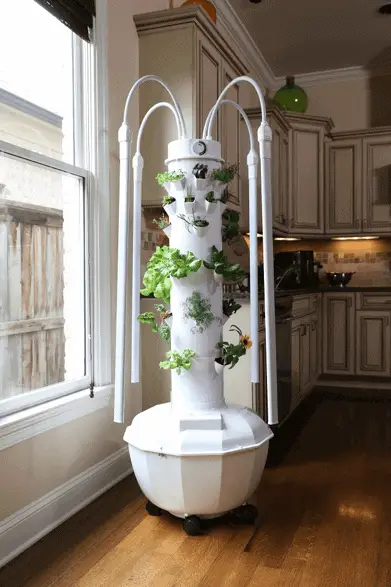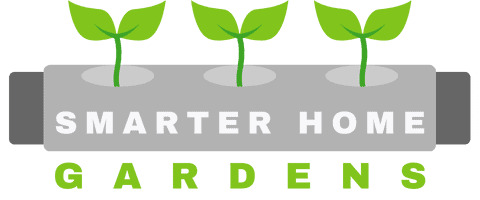
When I first received my shiny new tower garden I was so excited to get started. I remember looking at the tall, white, pocket-filled tower and feeling like I was from the future. Unfortunately, my tower garden didn’t stay white and shiny for long. Algae built up pretty quickly during my first season. I didn’t know how to properly clean it off, or even what I did wrong.
There are a few ways to prevent algae from building up in your tower garden. Ensuring that the tower is properly sealed is the most important. This prevents tiny spores from penetrating the system. It also blocks any light from reaching the nutrient-rich water which can trigger algae to reproduce.
After some more research, and some trial and error, I am now much better at keeping my tower garden clean and largely algae-free. In this article, I’ll share what I have learned so that you can prevent my mistakes and get ahead of any problems.
How to Prevent and Remove Algae From A Hydroponic Tower Garden
For my full guide on preventing and removing mold in hydroponics, check out my dedicated article.
Why are algae growing in your tower garden?
Let’s start off by understanding why algae could be growing inside your hydroponics system.
As a general rule, algae starts to grow in your tower garden because microscopic airborne spores find their way into the system. Once inside, the algae can feed on nutrient-rich water and thrive. Particularly if there is also access to a small amount of light.
It’s almost impossible to completely prevent algae from reaching your tower garden. Yet, there are a number of steps that I have learned that will help to prevent algae from getting out of control.

Are algae good or bad for hydroponics?
As a general rule, a small number of algae should be expected and is not harmful to your hydroponic tower garden. Algae only become problematic when it is left untreated and allowed to build up in greater quantities.
Large amounts of algae can clog pipes and prevent the pump from working which may deprive your plants of nutrients, water, and oxygen. Left over the long term, algae may cause substantial wear and tear to your tower garden system.
Preventing algae from building up in your tower garden
The key to preventing algae from building up in your tower garden is to remove its access to at least one of the key elements (water, nutrients, light) it needs to reproduce and thrive.
1. Seal everything properly
One of the most important things you can do is to keep your tower garden sealed tight. This means ensuring that the lid to the water reservoir shut properly and that all other openings, like those around the cups/pockets, are air-tight. When all possible openings are sealed properly algae spores will not be able to enter the system, preventing outbreaks before they can begin.
2. Prevent sunlight from reaching where it shouldn’t
Keeping everything sealed up at night and tight has the secondary benefit of preventing any light from reaching algae that may already be lurking inside your tower garden. Contact with even a small amount of sunlight can trigger algae spores to grow and reproduce. I take the additional steps of covering the water reservoir of my tower garden with a sack or basket to further reduce excess light.
3. Keep your water nice and clean
It’s more likely than not that algae spores will get inside your tower garden. Their favorite place to grow and reproduce is within the nutrient-rich water reservoir at the base of the tower. Ensure you are checking the reservoir regularly (ideally every 2 days). If you notice algae particles floating in the water it’s best to flush the water, clean the reservoir and replace it with a fresh batch.
4. Keep the outside of your tower garden clean
In addition to checking the inside of your tower garden for signs of it’s important to check the outside for signs of algae too. Common places are around all the seals and the plant pockets/cups. If you see algae forming, make sure you are frequently wiping it off (see below cleaning guide for tips on how best to do this). I usually the outside of my tower a good wipe down once a week to help keep it clean.

How do you clean algae from your tower garden?
Cleaning algae from the outside and inside of your tower garden is important but needs to be done in the right way to reduce the risk of harming the plants you are trying to grow. Do not use synthetic cleaners like bleach or other harmful chemicals that may damage your plants.
1. Scrub affected areas with vinegar and baking soda
I find that mixing a good amount of baking soda with apple cider vinegar to create a wet paste works exceptionally well for cleaning the outside of my hydroponic tower garden. Take a cloth or sponge and scrub affected areas firmly to remove any signs of algae. The same works for the inside of the tower and the water reservoir. But you must ensure to drain this first and replace the water once cleaning is finished.
2. Wash with warm water
Once you have scrubbed away all evidence of algae from the outside and inside of the tower, including the plant cups (if possible) and all seals, leave the baking powder/vinegar solution to sit for about 30 minutes. Once this time has passed, wash everything off with warm water and a soft brush. This should remove all evidence of algae and other dirt. A toothbrush can help to get at those hard-to-reach areas.
3. Soak in water, vinegar and baking soda (end of the season)
If you want to clean the entire system and you aren’t currently growing, say at the end of the season, follow the above steps before disassembling the entire tower and soaking it in a tub of warm water filled with baking soda and vinegar. Once soaked for 30 minutes, scrub each part with a soft brush or sponge to ensure all algae and dirt is removed.

Are hydroponic gardens hard to maintain?
One of the reasons I love hydroponics and my tower garden is that they are far easier to maintain than conventional gardens. Despite the need for cleaning, vertical gardens generally require less effort to water, are better protected from pests and diseases, and do not require tilling or any other form of ‘hard work.
I’ve actually written a whole article that goes into depth on how to maintain your vertical garden.
Final considerations
While you can always expect a little algae build-up in your hydroponic tower garden you should not be concerned. Algae is a normal part of growing but it shouldn’t be allowed to build up to disruptive levels that can block your plant’s access to water, nutrients, and oxygen.
Algae is cleaned away easily using a solution of vinegar and baking soda before washing with warm water.
